Mid-morning on 14 October 2013, a Buteo species was discovered flying low over the wood at Ribeira do Vinte on the east side of Corvo, Azores, by a team of Finnish birders. In the dull conditions their initial impression was of a dark bird and their conclusion at the time was that it was a Common Buzzard, and thus the news was radioed out as such – the last sighting confirming that it had dropped into a tree in the wood itself.
Being just a few hundred metres away near the bottom of Ribeira do Poço de Agua and knowing that Common Buzzard would be an even more fanciful occurrence on Corvo than some of the migratory Nearctic species, I rushed to gain a vantage point and soon noticed the bird again circling over the wood. As suspected, instant impressions at distance suggested that it was not Buteo buteo: the bird seemed larger and longer-winged, and the underparts and underwing coverts were strikingly dark. The bird had to be a dark-morph Rough-legged Hawk Buteo lagopus sanctijohannis and I relayed this opinion over the walkie-talkie, though distance and poor light hampered a definitive identification before it drifted off high to the north.
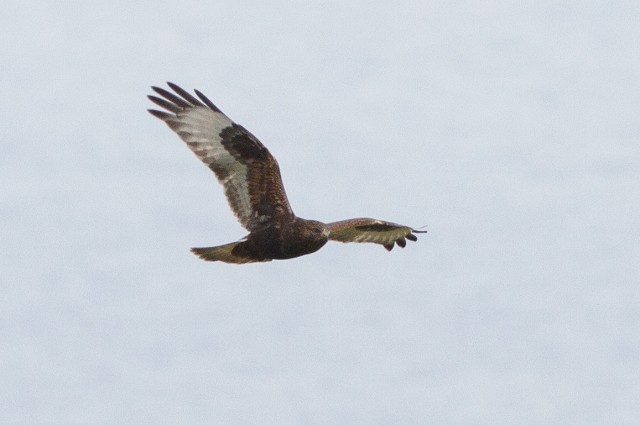
Dark-morph juvenile Rough-legged Hawk, Corvo, Azores (Josh Jones)
A few hours passed and I had climbed as high as the Caldeira Road having seen very little. On reaching the road, which gives a fine vantage over the east side of the island, I sat down to eat a sandwich. It was shortly afterwards that news came over the radio that the hawk was back, high over Coroa do Pico. It took me a while to pick it up from my position due to its height but it soon drifted closer — it appeared to be attempting to reach the crater, but failed several times over the following 15 minutes because of the brisk westerly wind. Given that I was only 50 metres or so below the crater edge I was fortunate to enjoy brilliant views of the bird as it struggled its way towards the rim, often watching it at eye-level as it circled.
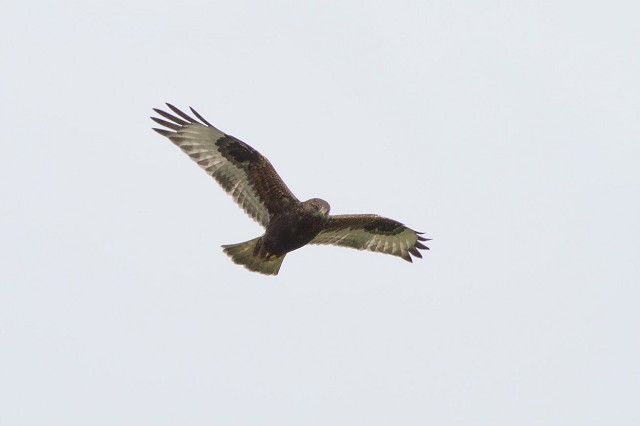
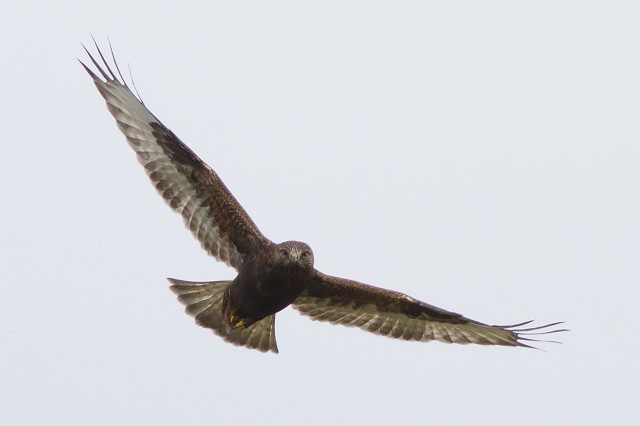
Dark-morph juvenile Rough-legged Hawk, Corvo, Azores. Two images taken as the bird flew close overhead. At distance, the underparts looked a uniform chocolate-brown but closer views reveal a ghosting of the typical plumage shown by pale-morph juvenile Rough-legged Hawks. The underwing coverts are noticeably paler than the almost black carpals, while the head and neck is slightly paler and streakier than the solid chocolate-brown belly. The undertail coverts, only just visible, are pale-fringed (Josh Jones).
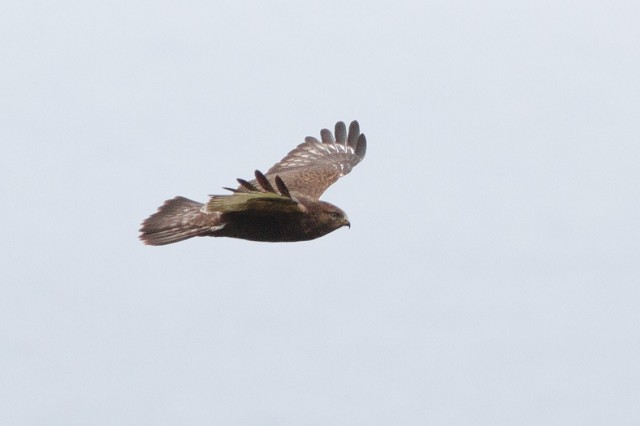
Dark-morph juvenile Rough-legged Hawk, Corvo, Azores. The upperparts are tinged with a warm rufous-brown while the extensive pale window to the upper side of the primaries is also visible. There is some paling towards the base of the tail (Josh Jones).
The bird soon gave up its attempt to beat the breeze and floated off south, losing height all the time. It was later relocated sitting on a wall near Ribeira da Ponte, and careful stalking allowed further brilliant views. Thanks to a couple of boisterous Azores Gulls forcing it from its perch, a series of satisfying flight shots were also obtained. By this point the identification as a dark-morph Rough-legged Hawk was beyond doubt: though at distance it could appear entirely dark below, the underparts actually illustrated a faint ghosting of the typical pattern shown by pale-morph juveniles of this species, with carpals darker than the underwing coverts and slightly paler, streakier head and undertail coverts than the solid, dark chocolate-brown belly. Save the tips of the outer primaries, the underside to the flight and tail feathers was an off-white, the secondaries lacking a distinct black fringe.
My high vantage point meant that uniquely I had obtained great views of the bird's upperparts. These were predominately a dark brown, noticeably tinged rufous, but the upper side of the primaries exhibited a striking pale window – this feature also present (but less prominent) on some of the central secondaries and the tail base; sparse barring was apparent on each of these blanched features. Close views showed the iris to be a mid-brown colour. A combination of these features, the ill-defined dark tips to the tail and secondaries and the bird's fresh plumage aged it as a juvenile.
A 'Rough-legged Buzzard' had already been seen by a handful of observers around the caldeira on 1, 7 and 9 October, and so correspondence was sought at dinner that evening as to whether this was the same individual. It quickly transpired that the original bird was a pale morph, and so the dark bird was evidently a new arrival. Both were seen subsequently with the dark morph last noted in the caldeira on 23 October.
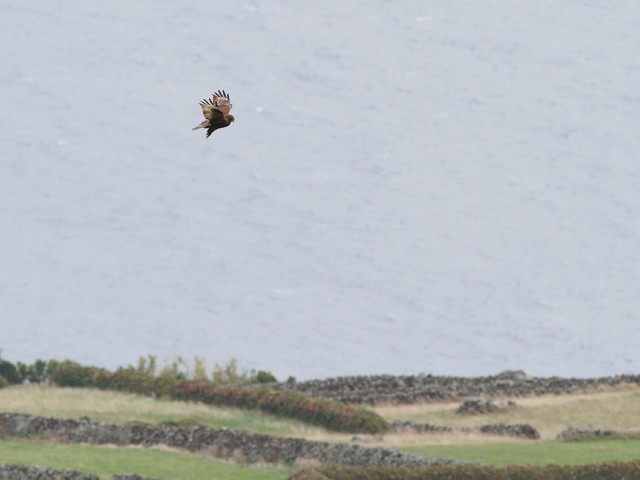
Dark-morph juvenile Rough-legged Hawk, Corvo, Azores (Josh Jones).
Identification and status in the Azores
Dark-morph Rough-legged Buzzards are unknown from European populations; in contrast, they are thought to constitute between 25 and 40 per cent of the eastern Canadian populations of the Nearctic form sanctijohannis (Sibley 2014), with intermediate birds apparently not uncommon. Therefore any dark bird in Western Europe can easily be attributed to this taxa. Though there are slight differences in biometrics with sanctijohannis averaging slightly smaller than European lagopus, pale morphs have traditionally been considered indistinguishable on field views alone. However, it is well worth mentioning that the colour and pattern of the leg feathering ('trousers') has recently been tentatively suggested as an area where the two may differ (Garner 2014, pers comm); initial study of both museum skins and online photographs suggests that many sanctijohannis show plain, unmarked (or very lightly marked) leg feathering while lagopus appear to invariably show extensive and prominent dark brown markings on the same feathers. However, it is worth noting that variation is rife: sanctijohannis can and do also show the more prominent marking typical of European birds while further research is required to assess whether the latter can ever display the unmarked feathering which features so prominently among their Nearctic counterparts.
Prior to 2013 there had been 11 Azorean records of Buteo lagopus, including two from Corvo (2002, 2010). By the end of that year the total had risen to 14, including the two birds on Corvo in October and another record from Criação Velha, Pico, on 15 December. Of these fourteen, the only dark morph to be recorded is that discussed above – a surprising outcome if Sibley's interpretation of dark morph frequency in eastern North America is accurate. Although just the one can therefore be confidently attributed to sanctijohannis based on current knowledge, the sensible assumption is that all Azorean records must relate to Nearctic birds. Take for example the three records in 2013; this was a particularly poor autumn (and subsequently winter) for Rough-legged Buzzards in Northern Europe with very few records from Sweden and southern Finland and just a handful from Britain, the latter registering sightings from 20 October onwards – significantly later than the arrival date of both birds on Corvo. The two records are therefore completely out of sync with the arrival of European birds on typical wintering grounds and, given the persistent westerly airflow from north-east Canada to the Azores throughout October 2013 which brought a rich selection of Nearctic birds to the archipelago, the odds are overwhelmingly stacked in favour of an arrival from the west. Many of the previous records relate to birds seen later in the autumn or winter and thus the differences in timing between Azorean birds and those arriving in North-West Europe are less pronounced; however, a pale morph seen on Terceira on 15 October 2010 precedes the main arrival on the British East Coast that autumn, which only occurred from 17 October onwards.
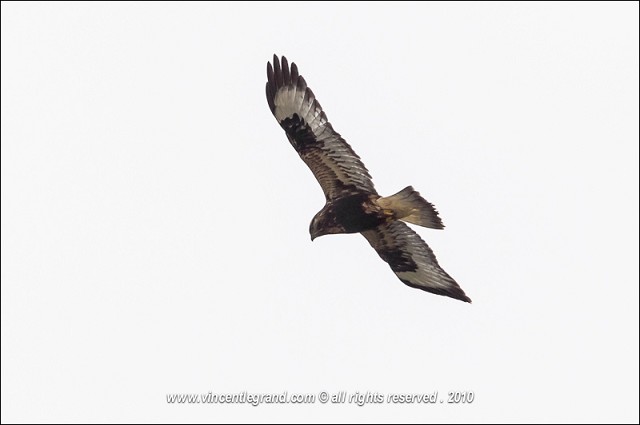
Presumed pale-morph Rough-legged Hawk, Corvo, Azores, October 2010 (Vincent Legrand).
Furthermore, it is also worth considering that Rough-legged Buzzard is an extremely scarce bird in the west and south-west of Britain as well as in Ireland, with birds rarely penetrating further south and west than central and south-east England. Given the Azores' isolated geographical position some 2,000 km to the south-west of Britain, it seems highly unlikely that any of the 'Rough-legged Buzzards' seen in the Azores relate to European lagopus.
Status in the wider Western Palearctic
It is not just the Azores that has recorded dark-morph sanctijohannis, with a handful of occurrences from elsewhere in the Western Palearctic (WP). The first WP record concerned a moribund individual in Iceland on 29 April 1980 and is the only dark representative of the 16 Rough-legged Buzzard/Hawk records from Iceland up to and including 2002. Another was found in similarly dire condition near Tórshavn, Faeroe Islands, on 6 April 2002 (Jensen 2003a); unfortunately it was covered in an unknown glue-like substance and died two days later, despite attempts to clean it (see a photo here). A later examination revealed it to be an adult female of good weight (not skinny); the substance on its feathers remained unidentified but is perhaps likely to have been picked up on a boat.
A further dark bird came aboard a Latvian fishing boat west of the Grand Bank and 350 miles east of Newfoundland at approximately 55°N, 48°W on 13 September 2003 (Jensen 2003b). It was in a poor state and was taken in to care until the boat reached Tórshavn, Faeroe Islands, where it was kept in captivity until May 2006. It was finally released from the ferry east of the Isle of Noss, Shetland, on 5 May. Photos of the bird taken near Lerwick on 6 May were initially labelled as Common Buzzard before its true identification was realised (Jensen 2006); it was last seen and photographed near Wester Quarff on 14 May.
The most recent record of a dark morph concerns a juvenile found exhausted in a field near Tulla, Co Clare (approx. 52.870°N, 8.760°W) and taken in to care on 11 October 2005 (Mullarney & Murphy 2005). It was identified in captivity where it recovered gradually, eventually becoming well enough to be released at North Slob, Co Wexford, on 2 November. Having flown off strongly, it was not seen again.
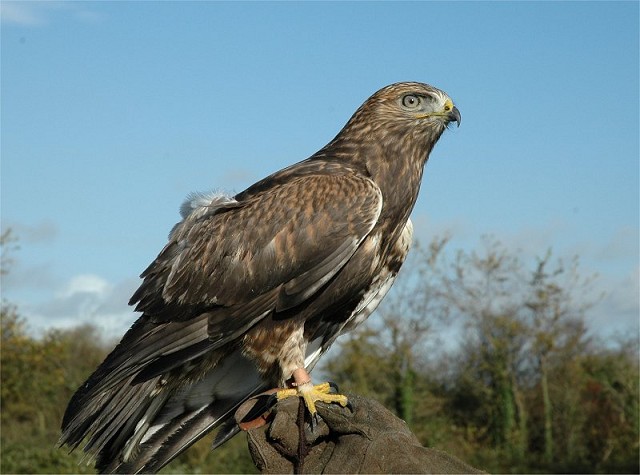
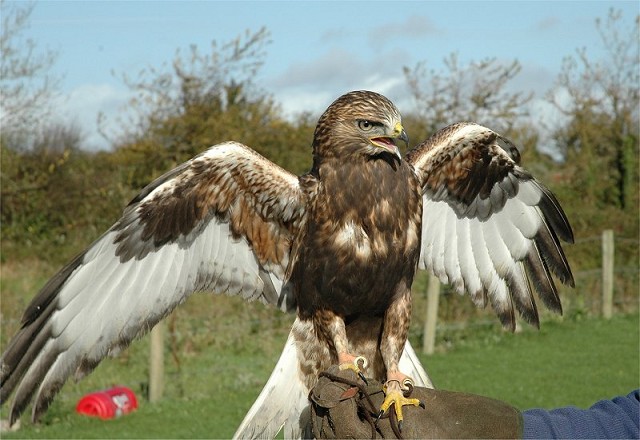
Dark-morph juvenile Rough-legged Hawk, Tulla, Co Clare, Ireland, October 2005. Found exhausted in a field near Tulla and taken in to care, this individual is superficially very similar in appearance to the Corvo bird, though it is slightly paler on the whole. Its underwing coverts are paler, thus exaggerating the characteristic dark carpal patches of Buteo lagopus more vividly. A creamy patch on the lower breast is also apparent (though may only be visible due to damaged/displaced feathers) and both the leg and undertail feathering are also extensively lighter in colour than on the Corvo individual (John N Murphy).
A small number of pale-morph sanctijohannis have also been suspected in the WP away from the Azores. For example, there have been two possibles on the Isles of Scilly (October 1984 and October 2001); the former arrived at the same time as several other transatlantic migrants and the latter was virtually the only 'Rough-legged Buzzard' seen in Britain that October (Millington 2001).
Presumed pale-morph juvenile Rough-legged Hawk, Eastern Isles, Scilly, October 2001 (Scilly Pelagics).
Also in 2001, a pale morph was found with a broken leg at Recess, Co Galway, on 6 October; it was taken in to care where it remained until its demise in February 2002. Its occurrence ties in closely with the arrival of the Scilly bird and the westerly locale certainly hints at a Nearctic origin. Coincidentally, no fewer than four pale birds were seen on the Azores between October and December 2001 with another recorded near Reykjavík, Iceland, on 21–27 October. Though nowhere near as far from Canada as the other records, belated news of a further pale morph that came aboard a Faeroese trawler off the west coast of Greenland at 64.30°N, 53.05°W on 25 September nevertheless added further weight to the suspicion that autumn 2001's influx is likely to have involved transatlantic vagrancy (Jensen 2002). The corpse was held and examination of the photos in Jensen's Birding World article clearly depict this bird to have the plain, unmarked 'trousers' recently raised as a possible feature of pale-morph sanctijohannis. Significantly, both the Scilly and Co Galway birds also appear to exhibit this, though photos of the Azorean birds either do not exist or are not of good enough quality to assess sufficiently. Of interest, another pale morph was picked up exhausted at Mount Stewart NT, Co Down, on 14 November 2011 and taken in to care. After being rehabilitated it was released in early December and remained in the area until February 2012. Photos on Facebook clearly depict this to be another richly-coloured individual with unmarked leg feathering.
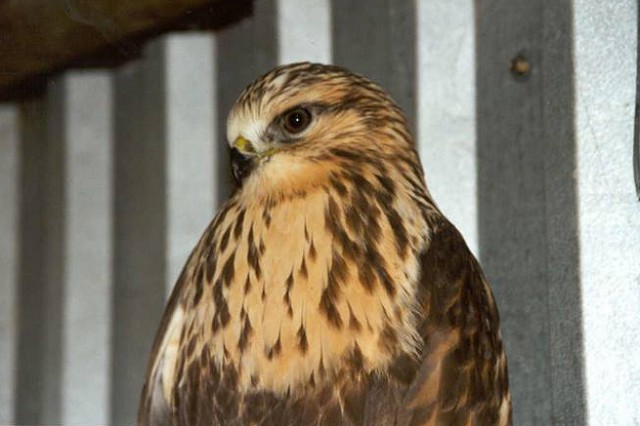
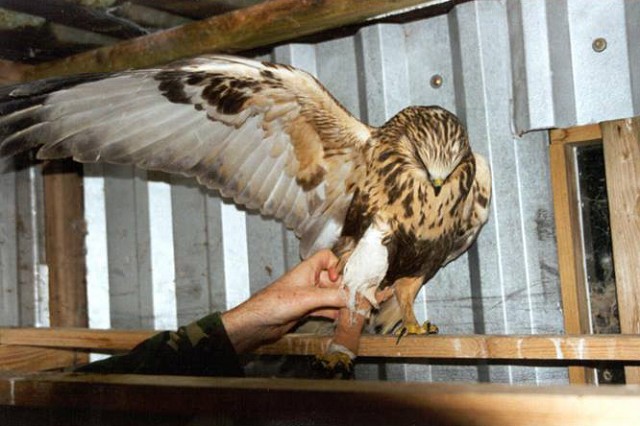
Presumed pale-morph juvenile Rough-legged Hawk, Co Galway, Ireland, October 2001. This bird was picked up with a broken leg in Connemara and taken in to care, but failed to recover and died in February 2002. Note the virtually unmarked leg feathering as well as the rich hue to the plumage. Study of museum skins and photos suggests that the undertail coverts, legs, head, neck and underwing coverts of Nearctic juveniles average a more intense, saturated creamy-yellow than in European birds, though this is quite variable in both subspecies and further study is required to quantify its validity as a possible discerning feature (Tony Murray).
Discussion
Jensen (2006) suggested that the paucity of dark-morph Rough-legged Hawk records in Europe could well be because they are overlooked. Of the aforementioned records, at least two were initially passed off as Common Buzzards in areas where that species is comparatively scarce: the re-sighting of the Faeroes/Shetland bird in May 2006, and the Corvo bird in 2013. What might happen with a vagrant in areas where Common Buzzard is numerous, as it is across much of Europe? Mullarney & Murphy (2005) cited that European field guides have traditionally failed to highlight the existence of a dark morph in North American populations and so it is entirely possible that a simple lack of knowledge among European birders could play a part in dark birds being overlooked on this side of the Atlantic. In fact, though the second edition of the Collins Bird Guide does mention that a dark form has very rarely been recorded in the region, it does not explain the Nearctic origin and only describes adult plumage.
Having said that, it seems unlikely that dark birds have been overlooked in the Azores. Common Buzzards of the local subspecies are absent from Corvo and Flores and not particularly common on the rest of the islands, and thus any unusual-looking Buteo across the archipelago is likely to be scrutinised, particularly on the western islands. The ratio of light to dark morph records in the archipelago is nevertheless striking, but may be at least partially explained by the latter forming the minority in sanctijohannis — even if this minority can apparently constitute almost half of all birds in some eastern areas (i.e. the most likely source of vagrants to the WP).
Previous records of dark birds from the likes of the Faeroe Islands and the Republic of Ireland dictate that Rough-legged Hawk can and does make it to north-west Europe, and therefore it is safe to assume that pale morphs must also be occurring. Indeed, given that they make up the majority of North American populations, one would expect pale-morph Rough-legged Hawks to occur more regularly on this side of the Atlantic than their dark counterparts. Assuming that all Azorean records are Nearctic in origin, then that would certainly seem to be the case. The problem is, of course, the stigma of separation from European lagopus. As this is not currently considered possible on field views alone then pale morph sanctijohannis are no doubt even more prone to being overlooked than their dark counterparts.
All things considered, Nearctic Rough-legged Hawk has traditionally proved a very rare vagrant to the Western Palearctic, and the bird present on Corvo from 14 October 2013 represents only the fifth dark-morph sanctijohannis to be documented in the region. However, the true status of the taxon is masked by uncertainty. Though the likelihood is that a number of pale morphs have already been documented, their identification remains tentative rather than definite due to a lack of recognised defining features between North American and European birds. That said, this may well prove to be on the brink of change and it is entirely possible that such advances — combined with increased observer awareness — will lead to a sudden upsurge in occurrences, as witnessed with the recent burst of Northern Harrier Circus cyaneus hudsonicus records in Britain and Ireland. Moreover, the ever-increasing popularity and quality of digital photography will also play a big part in the documentation of future candidate Rough-legged Hawks, both dark and pale, and further WP records of this fascinating and attractive taxon will no doubt be forthcoming.
References
Birding Azores: Online Rare Bird Database.Jensen, J-K. 2002. A Rough-legged Hawk off Greenland. Birding World 15: 348.
Jensen, J-K. 2003a. A Rough-legged Hawk on the Faeroe Islands. Birding World 16: 20-21.
Jensen, J-K. 2003b. In Western Palearctic News, Dark morph Rough-legged Hawk. Birding World 16: 455-461.
Jensen, J-K. 2006. Are dark morph Rough-legged Hawks overlooked in Europe? Birding World 16: 208-209.
Millington, R. 2001. A possible Rough-legged Hawk on the Isles of Scilly. Birding World 14: 439-440.
Mullarney, K. & Murphy, J. 2005. The Rough-legged Hawk in Ireland. Birding World 18: 503-504.
Sibley, D. A. 2014. The Sibley Guide to Birds. 2nd ed. New York: Knopf Publishing Group.
Acknowledgements
Thanks to Martin Garner of Birding Frontiers for the insightful discussion regarding the potential identification of pale morph Rough-legged Hawks and to Vincent Legrand and Tony Murray for allowing use of their images in this article.



